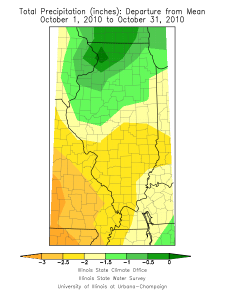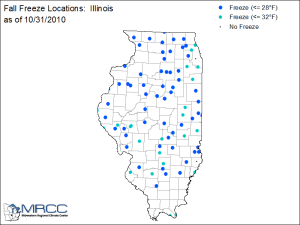As of July 13, 2011, the map of 30-day precipitation departures (figure below) showed a large area of below-average precipitation extending from eastern Iowa, through Illinois and Wisconsin and into parts of Michigan, Indiana, and Ohio. At first, this was not a concern because of the wet conditions that occurred through much of the spring. However, the lack of rainfall and hot conditions in the first part of July have begun to dry out the topsoil in Illinois. The rainfall departures range from 0.5 to 3 inches below average across northern and eastern Illinois.
Comparing the NASS report for July 5 and July 11:
- the Northwest crop reporting district (CRP) went from 11% dry to very dry topsoil to 30% dry to very dry in one week
- the Northeast CRP went from 4% dry to very dry to 29% dry to very dry in one week
- the East CRP went from 12% dry to very dry to 37% dry to very dry in one week.
The potential loss of water from soils from evaporation and transpiration from crops is on the order of 0.2 inches per day in Illinois now (link to potential evapo-transpiration maps). That means that we need about 1.4 inches of rain per week in July just to keep up with the demand from the crops. If the crops don’t get the water from rainfall then they have to rely more on soil moisture. So a week with no rain and temperatures in the 90s can dry out the topsoil quickly.
According to the Crop Watchers in the Illinois Farm Bureau’s FarmWeek, corn and soybeans in the sandy soils and in the thin soils on the ridges are showing signs of stress. Today we have seen slightly cooler temperatures across Illinois, along with some rain. However, the NWS is forecasting a return of hot weather over the weekend. In addition the NWS 6-10 day and 8-14 day forecast show a greater chance of above-average temperatures across all of Illinois. Those forecasts show a greater chance of below-average rainfall across the southern two-thirds of the state and near-to-above average rainfall in the northern third of the state.
While northern Illinois has been dry, much of southern and western Illinois has received much-above average rainfall, by as much as 2 to 5 inches or more in many locations. The wet conditions have led to flooded fields and widespread planting/replanting delays.





